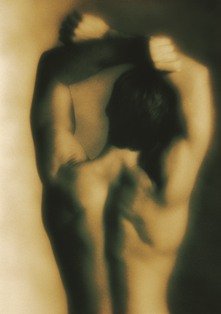Muscle Soreness - DOMS [ Delayed Onset Muscle Soreness]

Facts about Delayed Onset Muscle Soreness
Delayed Onset Muscle Soreness is seen after Intense Resistance training. Learn what it means, the causes, and how to prevent & reduce the muscle pain and get on with your workouts.
Muscle Soreness is a common complaint, especially among beginners or if you are training after a long interval.
Almost every bodybuilder has experienced it at one time or another and its your body's normal response to Intense Weight Training. In this article you will discover why it happens, how to prevent and reduce it and common questions regarding training while sore.
In exercise physiology terms it is called Delayed Onset Muscle Soreness or D.O.M.S.
What causes D.O.M.S.?
Although D.O.M.S. resembles the pain and discomfort you feel during exercises, it is different form the muscle pain you experience during your workouts. Muscle pain during workouts is due to the irritation of pain nerve ending by metabolic by-products of exercise metabolism and is different from Muscle Soreness of Delayed onset.
D.O.M.S. is typically experienced 24-48 hours after your training. On rare occasions it might extend for up to 96 hours { some studies have reported that DOMS may last up to 10 days}. DOMS is a multi-factorial condition and is due to a combination of one or more of the following factors,
- The micro trauma to the Muscle fibers{ muscle cells are called Muscle fibers }
- Increased Free radicals which damage the muscle tissue.
- Increase calcium leakage from muscle cells and accumulation of Inflammatory mediators like prostaglandins and leukotrienes.
- Eccentric Muscle contraction called negatives causes more muscle damage and therefore more soreness.
Muscle soreness may or may not be an indication of growth.
Symptoms - How does Muscle Soreness manifest?
Muscle Soreness usually is a discomfort and pain in the affected muscles. But it may also show muscle tenderness [muscle pains on touch], swelling called edema and limited range of motion. Any effort to move the muscles, even normal activities evoke pain.
This pain is however dull aching in nature, compare this to a sharp pain of muscle injury.
How to prevent Muscle Soreness?
If you have been reading ExerciseGoals.com and the accompanying FREE weight training guide, then you know how strong a supporter I am of proper Warm Up and Stretching Exercises. They play a major role in preventing Muscle soreness.
Always start slowly when you begin aWeight Training Program.
Make sure you read theStretching Exercises andWeight Training Basics before you begin.
Proper Warm Ups and Cool Downs will help prevent Muscle soreness.
Advanced Trainers - Although DOMS is common in beginners, advanced Weight Trainers are prone to develop muscle soreness if there is a sudden progression of intensity or change of exercises. When I started incorporating more than one Advanced Weight Training Exercise techniques in to my training routines at a time I did notice muscle soreness. So if you are adding newer techniques to your workouts add one intensity principle at a time, master it and then move on to the next principle. It will not only reduce Muscle soreness but will also allow to gauge the effectiveness of your newer training regime.
Many Bodybuilders including Ronnie Coleman have claimed that even though they train with high intensity consistently they never experience soreness and attribute it to their bodies getting used to the muscle overload over a period of time. That is their bodies have been conditioned to muscular overload. Exercise Physiology studies have shown that trained athletes have a better buffering of muscle ph as their muscles improve in their abilities to tolerate higher levels of lactic acid and free radicals.
Update - Recent studies in Runners and Weight Trainers have found that a post workout drink combining carbs and proteins ingested within 60 minutes reduces Muscle Soreness. This makes post workouts nutrition all the more important.
Treatment of Muscle Soreness.
As Muscle Soreness is a normal response of your body no active intervention is necessary. Proper rest and recuperation is enough.
If soreness is very annoying aspirin will help. Also you can try cryotherapy. Its fancy term for ice packs.
Muscle Soreness, when mild, is NOT an indication to stop exercising.
Newer Promises
Many researches are suggesting the use of glutamine for faster Muscle repair and development. As the most abundant amino acids in the Muscles, glutamine in some studies has shown promising results.
But in my opinion it is still on the wrong side of famous 80/20 rule I discussed in The TEN Commandments of Weight Training.
If you are training consistently, eating as recommended and taking multivitamins and whey supplements, then you might want to try glutamine for faster recovery. Please make sure you tell me your results with glutamine.
Soreness and Injury
Its important to differentiate D.O.M.S. from acute Weight Training Injuries. A soreness that does not go away, worsening pain and acute onset of pain are indications of an injury and will need an sports medicine consultation.
Related Articles
Back to Weight Training Tips Homepage.




